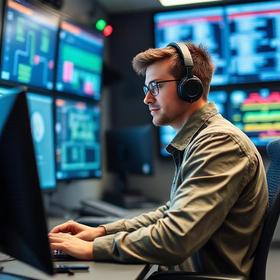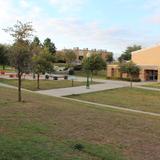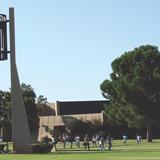- We are a progressive and public community college dedicated to providing students with dynamic centers of learning and promoting economic and community development while being resourceful and fiscally responsible.
School Highlights
Howard College serves 5,192 students (23% of students are full-time).
The college's student-teacher ratio of 18:1 is lower than the state community college average of 23:1.
Minority enrollment is 58% of the student body (majority Hispanic), which is less than the state average of 74%.
Quick Facts (2025-26)
- Enrollment: 5,192 students
- In-state tuition: $3,512
- Out-state tuition: $5,142
- Student-teacher ratio: 18:1
- Minority enrollment: 58%
- Source: Integrated Postsecondary Education Data System (IPEDS)
School Overview
The teacher population of 281 teachers has stayed relatively flat over five years.
Howard College
(TX) Community College Avg.
Carnegie Classification
Associate's Colleges: Mixed Transfer/Career & Technical-High Nontraditional
Baccalaureate/Associate's Colleges: Associate's Dominant
Institution Level
At least 2 but less than 4 years
At least 2 but less than 4 years
Institution Control
Public
Public
Total Faculty
281 staff
262 staff
School Calendar
Student Body
The student population of Howard College has grown by 20% over five years.
The student-teacher ratio of 18:1 has increased from 13:1 over five years.
The Howard College diversity score of 0.57 is less than the state average of 0.70. The school's diversity has stayed relatively flat over five years.
Total Enrollment
5,192 students
4,931 students
Student-Teacher Ratio
18:1
23:1
# Full-Time Students
1,195 students
909 students
# Part-Time Students
3,997 students
4,022 students
# Enrollment Undergraduate
519 students
403 students
# Full-Time Undergraduate Students
1,195 students
890 students
# Full-Time Graduate Students
n/a
40 students
# Part-Time Undergraduate Students
3,997 students
4,166 students
# Part-Time Graduate Students
n/a
47 students
Total Dormitory Capacity
252 students
252 students
% American Indian/Alaskan
n/a
n/a
% Asian
1%
6%
% Hispanic
50%
46%
% Black
3%
13%
% White
42%
26%
% Hawaiian
n/a
n/a
% Two or more races
3%
3%
% Non Resident races
1%
2%
% Unknown races
n/a
4%
Diversity Score
0.57
0.70
College Completion Rate (Students who graduate in less than 4 years)
28%
55%
College Completion Rate (Students who graduate in 4 years or more than 4 years)
n/a
34%
Average Graduate Earnings (10 Years)
$33,400
$34,600
Tuition and Acceptance Rate
The public in-state tuition of $3,512 is less than the state average of $3,764. The in-state tuition has declined by 11% over four years.
The public out-state tuition of $5,142 is less than the state average of $6,054. The out-state tuition has declined by 5% over four years.
In-State Tuition Fees
$3,512
$3,764
Out-State Tuition Fees
$5,142
$6,054
% Students Receiving Some Financial Aid
79%
84%
Median Debt for Graduates
$9,274
$10,765
Median Debt for Dropouts
$4,750
$5,500
Acceptance Rate
n/a
84%
Source: 2024 (or latest year available) Integrated Postsecondary Education Data System (IPEDS)
School Notes
- The Howard County Junior College District was created by a county-wide vote on November 17, 1945. Seven citizens of Howard County were elected on that same ballot to serve as a Board of Trustees. Howard College was first housed two miles west of downtown Big Spring in the hospital area of the former Air Force Bombardier School. The first session began on September 30, 1946. On September 12, 1951, the college was moved to a one hundred acre campus located in southeast Big Spring. On November 6, 1979, the Board of Trustees unanimously voted to establish the SouthWest Collegiate Institute for the Deaf as a part of the Howard County Junior College District. The first classes offered through this program began on August 25, 1980. Howard College/Big Spring physical facilities are located on a spacious campus. The 120-acre campus contains an administration-classroom complex, a two-story science building, a 14,000 square foot library building, a fitness center, a student union building, a music building, a practical arts building, an applied science center, a 28,000 square foot occupational building, residence halls for men and women, a 90,000 square foot coliseum complex, a baseball park, a softball park, and a football stadium with a seating capacity of ten thousand, utilized and maintained by the Big Spring Independent School District. Howard College is accredited by The Commission on Colleges of the Southern Association of Colleges and Schools to award associate degrees.
Frequently Asked Questions
How much does Howard College cost?
Howard College's tuition is approximately $3,512 for In-State students and $5,142 for Out-State students.
What schools are Howard College often compared to?
Howard Collegeis often viewed alongside schools like Western Texas College, South Plains College by visitors of our site.
Recent Articles

The Rise of Technical and Vocational Training in 2025
Explore the 2025 surge in technical and vocational training—enrollment, policy, costs, and why this path is gaining ground for students and parents.

Stackable Credentials: How Community Colleges Advance Careers
Discover how community colleges use stackable credentials to build career pathways, boost earnings, and enable lifelong learning in 2025.

High-Paying Jobs You Can Get with a Community College Degree
Discover top high-paying careers you can launch in 2025 with a community college (associate) degree and high-growth credentials in tech, healthcare and trades.












